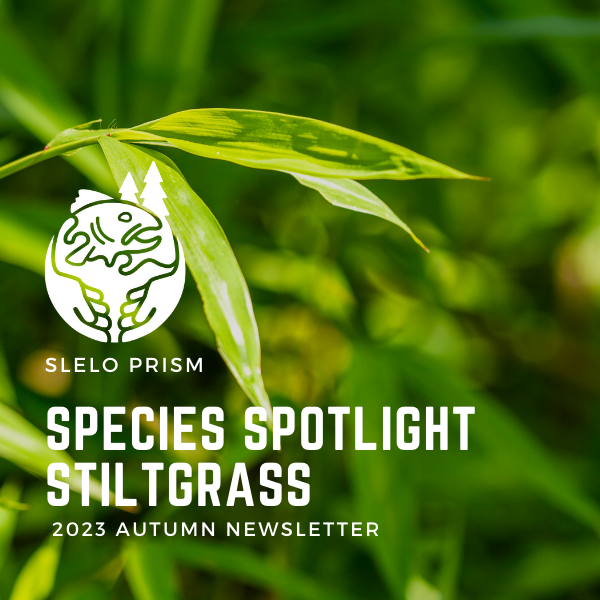This article was featured in the 2023 Autumn Newsletter by Allison Curl-2023 SLELO/TILT Watercraft Inspection Steward.
Microstegium vimineum is commonly known as stiltgrass is native to East Asia and the Caucasus mountains. The plant most likely came to the United States as packing materials from China, found in Tennessee in 1919 (1). For the past 100 years, it has been spreading across the eastern US to 24 states and territories. As of 2011, stiltgrass was found in 16 counties in New York, most heavily in the lower Hudson river area, but as far north as Oswego county (2) .
Stiltgrass prefers to live in nitrogen-rich, acidic to neutral soil. They can be found in a variety of ecosystems including woods, wetlands, and fields (2) . Deer typically eat native grasses but tend to shy away from stiltgrass aiding in the ability of the plant to spread (3) . When introduced to an area, stiltgrass has the ability to take over, crowding out ecologically important species. It can also have an impact on nutrient cycling and forest health.
Stiltgrass has thin, pale green, lance-shaped leaves, about 3 inches in length with a stripe of silver hairs down the midvein. Its leaves are arranged alternately along a branched stalk which can grow three feet in height. Leaves are smooth, a trait that helps distinguish them from native whitegrass which has a rough texture. Flowers are delicate and grow on spikes in late summer-fall.

Each year one plant can produce up to 1000 seeds (2). The seeds can remain viable for multiple years waiting for proper conditions
and can be spread to new areas by hitchhiking on shoe treads, vehicle tires, or through water(4). Seeds germinate after a disturbance such as flooding or high amounts of soil movement caused by logging, tilling, mowing, or construction. Therefore, minimizing disturbance to land reduces their spread potential (3).
Stiltgrass can be managed in multiple ways. Due to their shallow root system, stiltgrass can be easily dug or hand-pulled. Mechanical cuttings should occur in late summer, after seeds have germinated but before new seeds have formed. String trimming is more effective than mowing as it removes all stem tissue; whereas mowing may result in regrowth from the plant’s stem nodes. Timing is crucial for mechanical and chemical methods; to avoid a second flush of germination, trimming/mowing should be delayed until June and be completed by August. When using chemical methods, grass herbicides have been shown to be effective, but timing is difficult. The Penn State Extension recommends using a pre-emergence herbicide at least two weeks prior to expected germination and adding a low rate of imazapic or sulfometuron to the mixture to allow the herbicide to help retain the herbicide selectivity and allows application to occur closer to or even after germination (1) . Efforts to introduce or re-establish native plantings in treated areas, where deer browse is low, should also be considered.

Please fill out the form below to be added to our listserv and receive our seasonal newsletter, event invitations and other announcements.


